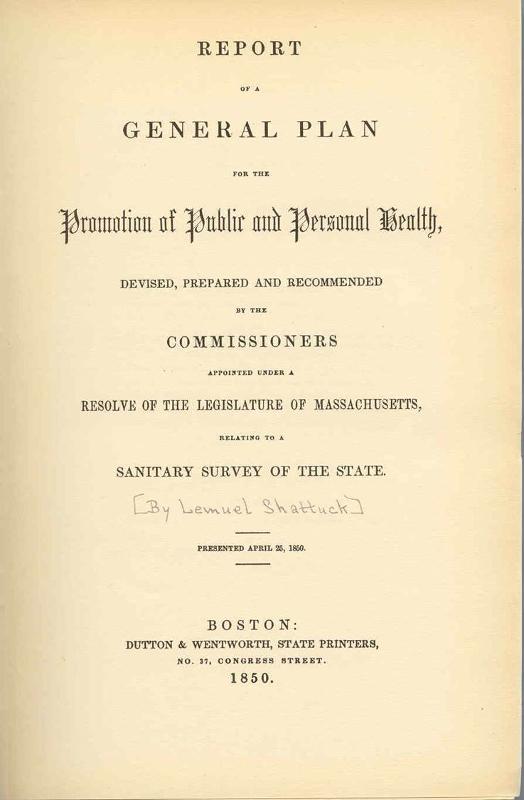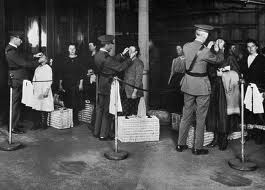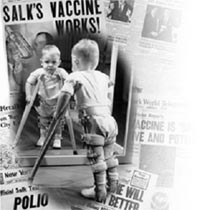Public Health in the United States
Events in the US paralleled those in the United Kingdom. The US also underwent a rapid transition from a rural, agricultural society to one that was intensely urban and industrial. Inventions such as the cotton gin that promoted agricultural production, but also decreased the need for farm workers, driving many to the cities for work. Economic growth and inventions spawned factories and textile mills in US cities.
Many of the facts and images below come from the History of the Public Health Service from the US National Library of Medicine.
The 1700s
- 1798 - Congress passes the Act for the Relief of Sick and Disabled Seamen and authorizes formation of the US Marine Hospital Service (MHS), which was the forerunner of the Public Health Service. Seamen often became ill while at sea and often were unable to find adequate health care in port cities. Their health was viewed as essential to the developing country, and a network of marine hospitals, mainly in port cities, was established by Congress in 1798 to care for sick and disabled seamen. Seamen were taxed 20 cents a month in order to raise funds to pay physicians and support the network of hospitals. This tax was abolished in 1884. From 1884 to 1906 funds were raised by a levy on merchant ships, and after 1906 funds were allocated by the US Congress.
- 1799 - Castle Island in Boston Harbor (pictured below) was chosen as the temporary site for the first marine hospital. Dr. Thomas Welsh, a Harvard College graduate and participant in the Revolutionary War battles at Lexington and Bunker Hill, was appointed as the physician in charge.

- 1799 - Boston establishes the first board of health and the first health department in the United States. Paul Revere is named as the first health officer.
The 1800s
- 1804 - The Boston Marine Hospital is established in the Charlestown section of Boston. Dr. Benjamin Waterhouse was appointed the physician in charge from 1807-1809.
- 1800 - Dr. Benjamin Waterhouse introduced smallpox vaccination to the United States
- 1842 - Lemuel Shattuck, a Massachusetts legislator, established the first US system for recording births, deaths and marriages. Largely through his efforts Massachusetts legislation became the model for all the other states in the Union. Among Shattuck's many contributions were his proposal for a standard nomenclature for disease; establishment of a system for recording mortality data by age, sex, occupation, socioeconomic level, and location; the application of data to programs in immunization, school health, smoking, and alcohol abuse.
- 1849 - The Massachusetts legislature appointed a Sanitary Commission 'to prepare and report to the next General Court a plan for a sanitary survey of the State', with Shattuck as Chief Commissioner and author of its report. The report (1850) was enthusiastically received by the New England Journal of Medicine, but the 50 recommendations in the report were otherwise ignored. Twenty years later the Secretary of the Board of Health of Massachusetts based his plans for public health on Shattuck's recommendations.

From from the US National Library of Medicine's web pages on The History of the Public Health Service:
"The 1870 reorganization [of the Marine Hospital Service] also changed the general character of the Service. It became national in scope and military in outlook and organization. Medical officers, called surgeons, were required to pass entrance examinations and wear uniforms. In 1889, when the Commissioned Corps was formally recognized by legislative action, the medical officers were given titles and pay corresponding to Army and Navy grades. Physicians who passed the examinations were appointed to the general service, rather than to a particular hospital, and were assigned wherever needed. The goal was to create a professional, mobile, health corps, free as possible from political favoritism and patronage, and able to deal with the new health needs of a rapidly growing and industrializing nation."
Epidemics of contagious diseases, such as small pox, yellow fever, and cholera, had devastating effects throughout the 19th century. They killed many people, spread panic and fear, disrupted government, and caused Congress to enact laws to stop their importation and spread. As a result of these new laws, the functions of the MHS were expanded greatly beyond the medical relief of the sick seamen to include the supervision of national quarantine (ship inspection and disinfection), the medical inspection of immigrants, the prevention of interstate spread of disease, and general investigations in the field of public health, such as that of yellow fever epidemics."
- 1874 - The Massachusetts State Board of Health instituted a voluntary plan for weekly reporting of disease by physicians.
- 1884 - Massachusetts passed legislation requiring the reporting of "diseases dangerous to the public health" and imposed fines for not reporting
- 1887 - A small "Hygienic Laboratory" was established at the marine hospital on Staten Island to aid in the diagnosis of infectious diseases among passengers of incoming ships. The laboratory later moved to Washington, D.C., and eventually evolved into the National Institutes of Health.
The video below is a segment from a PBS documentary on public health. This particular segment focuses on events at the dawn of the 20th century when bubonic plague threatened San Francisco. Note the futile and inappropriate use of quarantine to deal with the threat of plague. The last section of the clip describes a broad array of public health interventions that eventually emerged.
Bubonic Plague Video Transcript
- 1891 - The Immigration Act of 1891 required that all immigrants entering the US be given a health examination by PHS physicians. The law stipulated the exclusion of "all idiots, insane persons, paupers or persons likely to become public charges, persons suffering from a loathsome or dangerous contagious disease," and criminals. The largest inspection center was on Ellis Island in New York Harbor.

- 1894 - The first epidemic of polio strikes the United States.
The 1900s
- 1900 - Some estimates indicate that HIV was transmitted from monkeys to humans as early as 1884-1924, but was either unrecognized or failed to initiate human to human transmission until later.
- 1902 - The US Congress expanded the scientific research work at the Hygienic Laboratory and gave it a definite budget. The legislation required the Surgeon General to organize conferences of local and national health officials in order to coordinate state and national public health activities. The Marine Hospital Service was renamed the Public Health and Marine Hospital Services (PHMHS) to reflect its broader scope.
- 1906 - Congress passed the Federal Meat Inspection Act requiring the Department of Agriculture to inspect meats entering interstate commerce. They also passed the Food and Drugs Act. The law forbade adulteration and misbranding of foods, drinks, and drugs in interstate commerce, but contained few specific requirements to insure compliance.
From from the US National Library of Medicine's web pages on The History of the Public Health Service:
"The working environment and its effect on worker's health became a major area of study for the Public Health Service starting in 1910. Investigations in the garment making industry, as illustrated by these women making flowers, revealed unsanitary conditions and an excessive rate of tuberculosis. Other studies were done of silicosis among miners, sanitation and working conditions in the steel industry, lead poisoning in the pottery industry, and radiation hazards in the radium dial painting industry."
- 1912 - The PHMHS was renamed the United States Public Health Service, and it was authorized to investigate human diseases such as, tuberculosis, hookworm, malaria, and leprosy), sanitation, water supplies and sewage disposal.
- 1916 - Johns Hopkins University founds the first school of public health in the the United States with a grant of $267,000 from the Rockefeller Foundation. The Rockefeller Foundation later supported schools of public health at Harvard and the University of Michigan.
- 1918 - The influenza pandemic of 1918 struck. It is believed to have caused at least 25-50 million deaths worldwide.
- 1925 All states begin participating in national reporting of disease
- 1938 Congress passed the Federal Food, Drug, and Cosmetic Act of 1938, and major amendments to the law were made in 1954, 1958, and 1960. Today the law requires manufacturers to provide scientific proof of a new drug's safety. The law also makes dangerous or falsely labeled cosmetics and therapeutic devices illegal. Enforcement of these laws is the mission of the Food and Drug Administration (FDA), which is tasked with ensuring that foods are safe and wholesome. It also ensures that drugs and medical devices are safe and effective, and that cosmetics are harmless. Provisions are also made to ensure accurately labeling and that radiofrequency emissions from electronic devices is not hazardous to consumers.
- 1948 Richard Doll and Bradford Hill conducted a landmark epidemiologic investigation of the cause of the remarkable increase in lung cancer that had occurred during the 20th century. They identified lung cancer patients in 20 London hospitals and enrolled a comparison group of non-cancer patients and conducted a case-control study. Somewhat to the surprise of Doll and Hill, the study found that the one consistent difference between lung cancer patients and the non-cancer controls was that the cancer patients were more frequently smokers, and they were heavier smokers. In retrospect, the study was quite carefully done and quite convincing. Nevertheless, it initially stirred much controversy, even among the medical community. Smoking was extremely prevalent, even in physicians, and many refused to believe that it could be a cause of cancer. Other studies were conducted which corroborated these findings, and eventually the importance of the study was recognized, not only for establishing the link between smoking and lung cancer, but for establishing the role of case-control studies. At the time, case-control studies were infrequently done, and careful standards for their conduct had not been established.
In the video below Sir Richard Doll briefly describes the study that he and Bradford Hill conducted in 1948. (R. Doll and A. B. Hill, 'Smoking and carcinoma of the lung: preliminary report', BMJ, 1950, 2.746). The video is a segment of a PBS video on public health.
Sir Richard Doll Video Transcript
- 1948 The Framingham Heart Study began with the goal of identifying the factors that contribute to cardiovascular disease by following its development over a long period of time in a large group of disease-free participants. The researchers recruited 5,209 men and women between the ages of 30 and 62 from the town of Framingham, Massachusetts, and began the first round of extensive physical examinations and lifestyle interviews that they would later analyze for common patterns related to cardiovascular disease. Since 1948, the subjects have continued to return to the study every two years for a detailed medical history, physical examination, and laboratory tests. In 1971 the Study enrolled a second generation - 5,124 of the original participants' adult children and their spouses - to participate in similar examinations." Click on this link to see an excellent PBS video on the history of the Framingham Heart Study and its impact on heart disease.
From from the US National Library of Medicine's web pages on The History of the Public Health Service:
"Medical discoveries and public health campaigns have almost eliminated deaths from the common diseases of childhood such as measles, diphtheria, scarlet fever, and whooping cough. As a result of these successes nearly 20 years were added to the average life expectancy at birth between 1900 and 1950-from 47 to 67 years."
"As epidemic diseases were brought under control the Public Health Service began to shift its attention to other areas such as cancer, heart disease, health in the workplace, and the impact of environmental problems, such as toxic waste disposal, on health. But the Public Health Service is still called upon to investigate outbreaks of disease such as Legionnaire's, toxic shock syndrome, and now the deadliest epidemic of our age -- AIDS. Much of the work of the early plague fighters and sanitarians is now carried out by the scientists at the Centers for Disease Control and Prevention (CDC) in Atlanta, Georgia."
- 1952 Polio cases surge in the US. Early testing of the vaccine developed by Jonas Salk is encouraging.
- 1953 Under President Eisenhower, Congress created the Department of Health, Education, and Welfare (HEW).
- 1954 A large scale clinical trial of the Salk vaccine begins

Image of small boy with polio standing with crutches
- 1959 Rene Dubos published a landmark book entitled "The Mirage of Health" in which he convincingly argued that the decline in mortality since 1850 was not primarily due to laboratory medicine; it was due to control of infectious disease as a result of sanitation and improvements in nutrition. He also pointed out that Western health was not optimal and that life expectation at age 45 had improved little. Moreover, one out of four Americans spent at least some time in mental hospitals. Increasing levels of drug dependency (all kinds of drugs) also indicated that health was not optimal. Dubos took the position that medicine's concept of specific etiologies (and therefore magic bullets that could cure disease) was misleading. He said that disease is complex and tends to be rooted in social, physical, and cultural environment in which people lived.
- 1970 The Occupational Safety and Health Act was passed by Congress, and the Occupational Safety and Health Administration was founded in 1971.
- 1970 The Environmental Protection Agency (EPA) was established to consolidate federal research, monitoring, standard-setting and enforcement activities to ensure environmental protection.
- 1979 HEW's educational tasks were transferred to the new Department of Education and responsibility for health was given to the newly organized Department of Health and Human Services (HHS).
- 1979 Smallpox is declared eradicated by the World Health Organization. The eradication of smallpox, one of the deadliest and most dreaded diseases, was the result of a massive global effort utilizing case finding and vaccination. The last known case occurred in 1977 in Somalia.
- 1980 President Jimmy Carter signed into law the Comprehensive Environmental Response, Compensation and Liability Act (CERCLA or Superfund). This historic new statute gave EPA the authority to clean up uncontrolled hazardous waste sites and spills.
- 1981 Dr. Michael Gottlieb and his associates report on four previously healthy young men who had developed Pneumocystis carinii pneumonia. They hypothesized that this was a new syndrome of acquired immunodeficiency cause by a sexually transmitted infectious agent.
- 2002 The Institute of Medicine issued a report entitled "Who Will Keep the Public Healthy?" The report concluded that "... public health professionals must have a framework for action and an understanding of the forces that impact on health, a model of health that emphasizes the linkages and relationships among multiple determinants affecting health. Such an ecological model, the committee believes, is key to effectively addressing the challenges of the 21st century."
